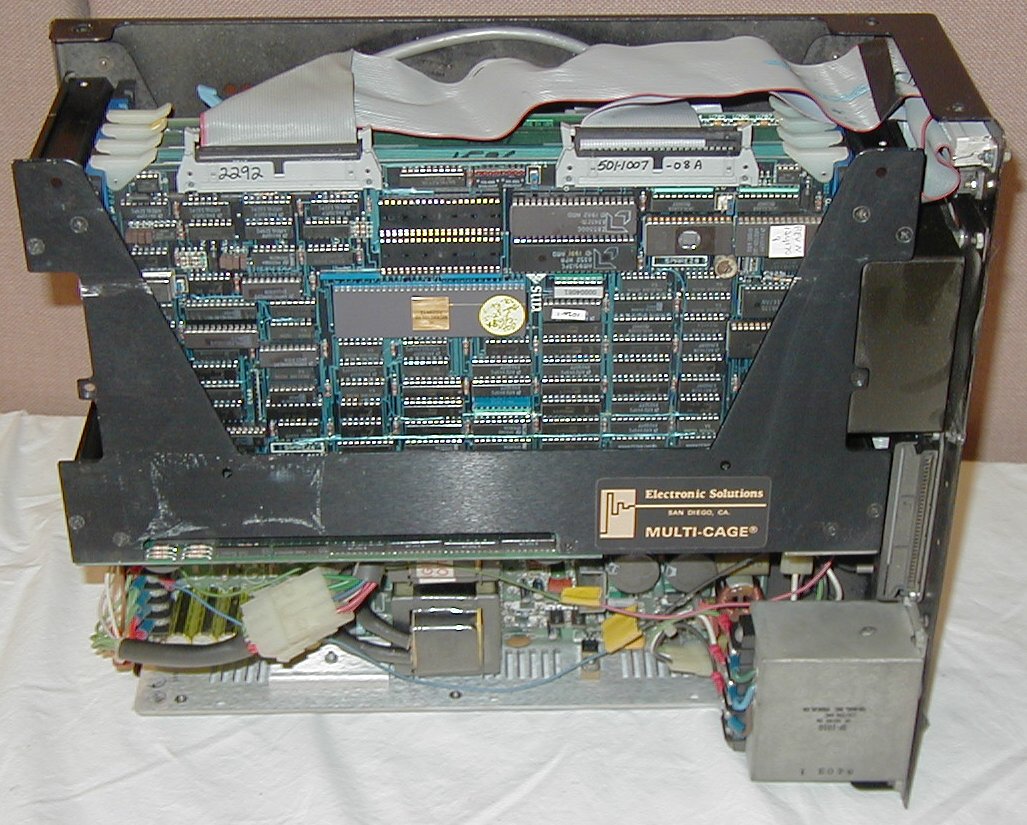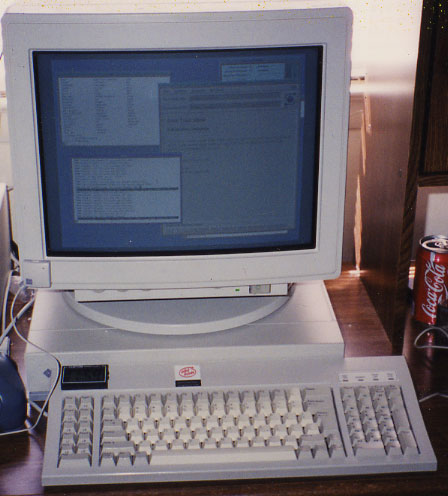|
SUN Workstation
The SUN workstation was a modular computer system designed at Stanford University in the early 1980s. It became the seed technology for many commercial products, including the original workstations from Sun Microsystems. History In 1979 Xerox donated some Alto computers, developed at their Palo Alto Research Center, to Stanford's Computer Science Department, as well as other universities that were developing the early Internet. The Altos were connected using Ethernet to form several local area networks. The SUN's design was inspired by that of the Alto, but used lower-cost modular components. (Many words are spelled phonetically) The project name was derived from the initials of the campus' Stanford University Network. CSL Technical Report 229 (First author name is misspelled on cover) Professor Forest Baskett suggested the best-known configuration: a relatively low-cost personal workstation for computer-aided logic design work. The design created a 3M computer: a 1 million inst ... [...More Info...] [...Related Items...] OR: [Wikipedia] [Google] [Baidu] |
:Category:Sun Microsystems Hardware
Computer hardware by Sun Microsystems Sun Microsystems, Inc. (Sun for short) was an American technology company that sold computers, computer components, software, and information technology services and created the Java programming language, the Solaris operating system, ZFS, the ... Sun Microsystems Hardware Computer hardware by company ... [...More Info...] [...Related Items...] OR: [Wikipedia] [Google] [Baidu] |
Andy Bechtolsheim
Andreas Maria Maximilian Freiherr von Mauchenheim genannt Bechtolsheim (born 30 September 1955) is a German electrical engineer, entrepreneur and investor. He co-founded Sun Microsystems in 1982 and was its chief hardware designer. His net worth reached $7 billion in September 2018.Andreas von Bechtolsheim profile forbes.com, 14 February 2018. Early life Bechtolsheim was born at Hängeberg am Ammersee, located in , Landsberg, |
Sun100U Cardcage
Sun-1 was the first generation of UNIX computer workstations and servers produced by Sun Microsystems, launched in May 1982. These were based on a CPU board designed by Andy Bechtolsheim while he was a graduate student at Stanford University and funded by DARPA. The Sun-1 systems ran SunOS 0.9, a port of UniSoft's UniPlus V7 port of Seventh Edition UNIX to the Motorola 68000 microprocessor, with no window system. Early Sun-1 workstations and servers used the original Sun logo, a series of red "U"s laid out in a square, rather than the more familiar purple diamond shape used later. The first Sun-1 workstation was sold to Solo Systems in May 1982. The Sun-1/100 was used in the original Lucasfilm EditDroid non-linear editing system. Models Hardware The Sun-1 workstation was based on the Stanford University SUN workstation designed by Andy Bechtolsheim (advised by Vaughan Pratt and Forest Baskett), a graduate student and co-founder of Sun Microsystems. At the heart of this de ... [...More Info...] [...Related Items...] OR: [Wikipedia] [Google] [Baidu] |
Motorola 68000
The Motorola 68000 (sometimes shortened to Motorola 68k or m68k and usually pronounced "sixty-eight-thousand") is a 16/32-bit complex instruction set computer (CISC) microprocessor, introduced in 1979 by Motorola Semiconductor Products Sector. The design implements a 32-bit instruction set, with 32-bit registers and a 16-bit internal data bus. The address bus is 24 bits and does not use memory segmentation, which made it easier to program for. Internally, it uses a 16-bit data arithmetic logic unit (ALU) and two more 16-bit ALUs used mostly for addresses, and has a 16-bit external data bus. For this reason, Motorola termed it a 16/32-bit processor. As one of the first widely available processors with a 32-bit instruction set, and running at relatively high speeds for the era, the 68k was a popular design through the 1980s. It was widely used in a new generation of personal computers with graphical user interfaces, including the Macintosh 128K, Amiga, Atari ST, and X68000. Th ... [...More Info...] [...Related Items...] OR: [Wikipedia] [Google] [Baidu] |
Printed Circuit Board
A printed circuit board (PCB; also printed wiring board or PWB) is a medium used in Electrical engineering, electrical and electronic engineering to connect electronic components to one another in a controlled manner. It takes the form of a Lamination, laminated sandwich structure of conductive and insulating layers: each of the conductive layers is designed with an artwork pattern of traces, planes and other features (similar to wires on a flat surface) Chemical milling, etched from one or more sheet layers of copper Lamination, laminated onto and/or between sheet layers of a Insulator (electricity), non-conductive substrate. Electrical components may be fixed to conductive pads on the outer layers in the shape designed to accept the component's terminals, generally by means of soldering, to both electrically connect and mechanically fasten them to it. Another manufacturing process adds Via (electronics), vias: plated-through holes that allow interconnections between layers. ... [...More Info...] [...Related Items...] OR: [Wikipedia] [Google] [Baidu] |
Wire Wrap
Wire wrap is an electronic component assembly technique that was invented to wire telephone crossbar switches, and later adapted to construct electronic circuit boards. Electronic components mounted on an insulating board are interconnected by lengths of insulated wire run between their terminals, with the connections made by wrapping several turns of uninsulated sections of the wire around a component lead or a socket pin. Wires can be wrapped by hand or by machine, and can be hand-modified afterwards. It was popular for large-scale manufacturing in the 1960s and early 1970s, and continues today to be used for short runs and prototypes. The method eliminates the design and fabrication of a printed circuit board. Wire wrapping is unusual among other prototyping technologies since it allows for complex assemblies to be produced by automated equipment, but then easily repaired or modified by hand. Wire wrap construction can produce assemblies which are more reliable than printe ... [...More Info...] [...Related Items...] OR: [Wikipedia] [Google] [Baidu] |
SCALD
The structured computer-aided logic design (SCALD) software was a computer aided design system developed for building the S-1 computer. It used the Stanford University Drawing System (SUDS), and it was developed by Thomas M. McWilliams and Lawrence Curtis Widdoes, Jr. The work led to the start of the Valid Logic Systems Cadence Design Systems, Inc. (stylized as cādence), headquartered in San Jose, California, is an American multinational computational software company, founded in 1988 by the merger of SDA Systems and ECAD, Inc. The company produces software, ... company (briefly known as SCALD Corporation) in 1981, which was purchased by Cadence Design in 1991. McWilliams and Widdoes won the W. Wallace McDowell Award in 1984 for the SCALD methodology. See also * Static timing analysis References * * * Electronic design automation Lawrence Livermore National Laboratory {{CAD-software-stub ... [...More Info...] [...Related Items...] OR: [Wikipedia] [Google] [Baidu] |
Foonly
Foonly Inc. was an American computer company formed by Dave Poole in 1976, that produced a series of ''DEC PDP-10'' compatible mainframe computers, named ''Foonly F1'' to ''Foonly F5''. The first and most famous Foonly machine, the ''F1'', was the computer used by Triple-I to create some of the computer-generated imagery in the 1982 film ''Tron''. History At the beginning of the 1970s, the Stanford Artificial Intelligence Laboratory (SAIL) began to study the building of a new computer to replace their ''DEC PDP-10 KA-10'', by a far more powerful machine, with a funding from Defense Advanced Research Projects Agency (DARPA). This project was named "''Super-Foonly''", and was developed by a team led by Phil Petit, Jack Holloway, and Dave Poole. The name itself came from FOO NLI, an error message emitted by a PDP-10 assembler at SAIL meaning "FOO is Not a Legal Identifier". In 1974, DARPA cut the funding, and a large part of the team went to DEC to develop the ''PDP-10 model KL10'' ... [...More Info...] [...Related Items...] OR: [Wikipedia] [Google] [Baidu] |
Stanford University Drawing System
Stanford University, officially Leland Stanford Junior University, is a private research university in Stanford, California. The campus occupies , among the largest in the United States, and enrolls over 17,000 students. Stanford is considered among the most prestigious universities in the world. Stanford was founded in 1885 by Leland and Jane Stanford in memory of their only child, Leland Stanford Jr., who had died of typhoid fever at age 15 the previous year. Leland Stanford was a U.S. senator and former governor of California who made his fortune as a railroad tycoon. The school admitted its first students on October 1, 1891, as a coeducational and non-denominational institution. Stanford University struggled financially after the death of Leland Stanford in 1893 and again after much of the campus was damaged by the 1906 San Francisco earthquake. Following World War II, provost of Stanford Frederick Terman inspired and supported faculty and graduates' entrepreneurial ... [...More Info...] [...Related Items...] OR: [Wikipedia] [Google] [Baidu] |
Stanford Artificial Intelligence Laboratory
Stanford University has many centers and institutes dedicated to the study of various specific topics. These centers and institutes may be within a department, within a school but across departments, an independent laboratory, institute or center reporting directly to the dean of research and outside any school, or semi-independent of the university itself. Independent laboratories, institutes and centers These report directly to the vice-provost and dean of research and are outside any school though any faculty involved in them must belong to a department in one of the schools. These include Bio-X and Spectrum in the area of Biological and Life Sciences; Precourt Institute for Energy and Woods Institute for the Environment in the Environmental Sciences area; the Center for Advanced Study in the Behavioral Sciences (CASBS), the Center for the Study of Language and Information (CSLI) (see below), Freeman Spogli Institute for International Studies (FSI) (see below), Human-Sciences ... [...More Info...] [...Related Items...] OR: [Wikipedia] [Google] [Baidu] |
ECAD
Electronic design automation (EDA), also referred to as electronic computer-aided design (ECAD), is a category of software tools for designing electronic systems such as integrated circuits and printed circuit boards. The tools work together in a design flow that chip designers use to design and analyze entire semiconductor chips. Since a modern semiconductor chip can have billions of components, EDA tools are essential for their design; this article in particular describes EDA specifically with respect to integrated circuits (ICs). History Early days Prior to the development of EDA, integrated circuits were designed by hand and manually laid out. Some advanced shops used geometric software to generate tapes for a Gerber photoplotter, responsible for generating a monochromatic exposure image, but even those copied digital recordings of mechanically drawn components. The process was fundamentally graphic, with the translation from electronics to graphics done manuall ... [...More Info...] [...Related Items...] OR: [Wikipedia] [Google] [Baidu] |
Multibus
Multibus is a computer bus standard used in industrial systems. It was developed by Intel Corporation and was adopted as the IEEE 796 bus. The Multibus specification was important because it was a robust, well-thought out industry standard with a relatively large form factor, so complex devices could be designed on it. Because it was a well-defined and well-documented industry standard, it allowed a Multibus-compatible industry to grow around it, with many companies making card cages and enclosures for it. Many others made CPU, memory, and other peripheral boards. In 1982 there were over 100 Multibus board and systems manufacturers. This allowed complex systems to be built from commercial off-the-shelf hardware, and also allowed companies to innovate by designing a proprietary Multibus board and then integrating it with other vendors' hardware to create a system. A good example of this was Sun Microsystems with their Sun-1 and Sun-2 workstations. Sun built custom-designed CPU, ... [...More Info...] [...Related Items...] OR: [Wikipedia] [Google] [Baidu] |






